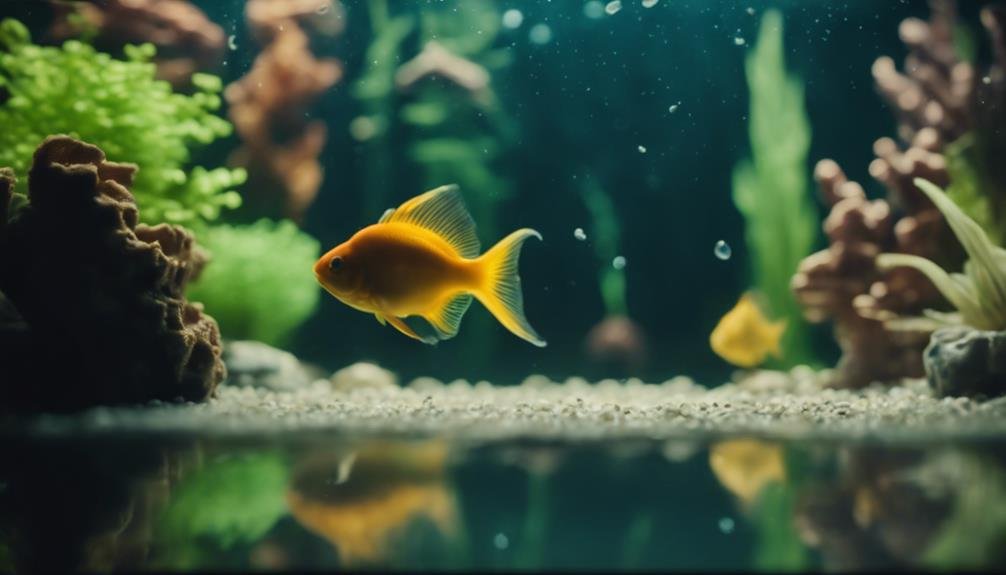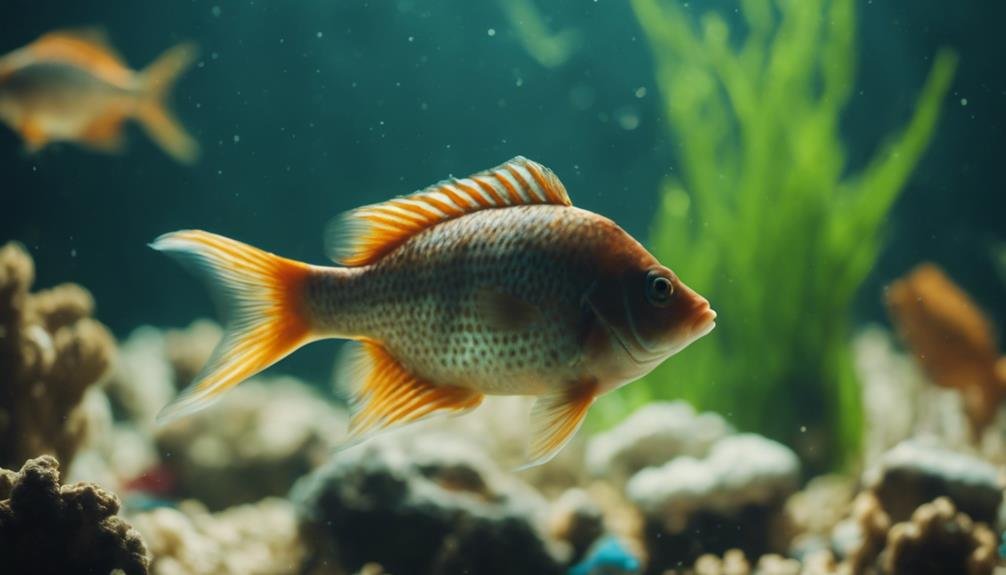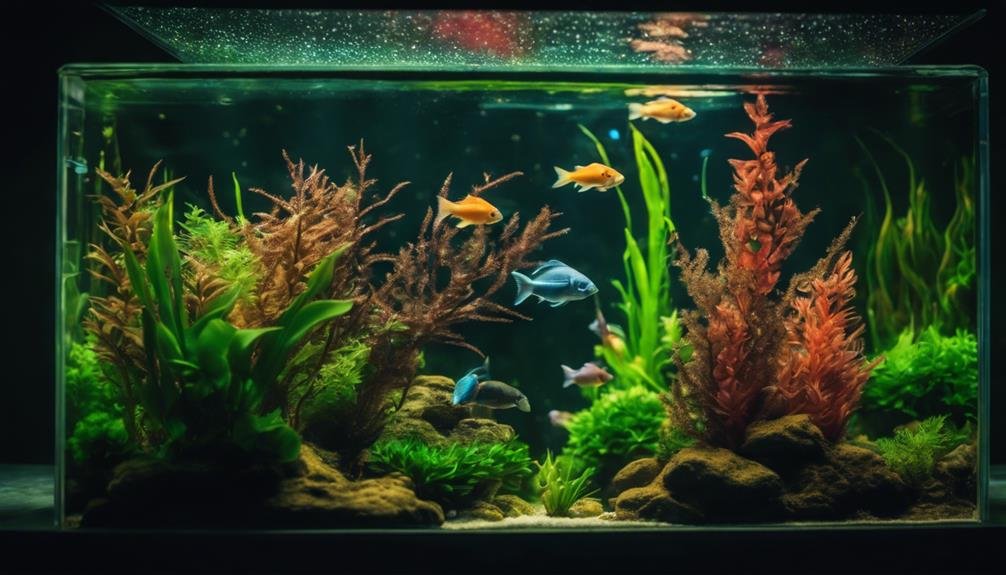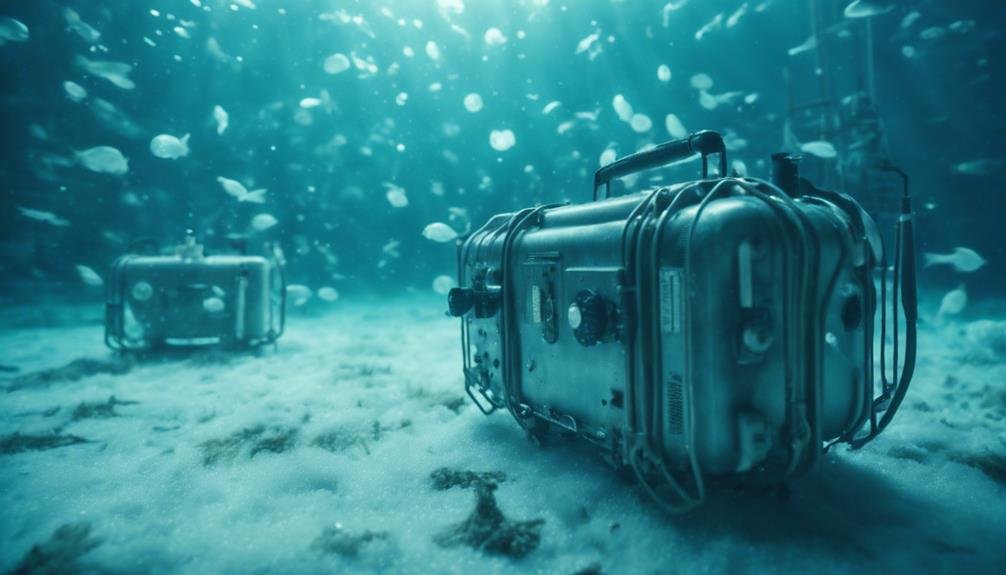To ensure the well-being of our fish during colder months, our focus will be on maintaining the optimal water temperature by utilizing proper insulation and heating equipment.
It is crucial to prevent oxygen depletion by increasing surface agitation and regularly monitoring oxygen levels in the water. Adjusting feeding schedules and amounts according to the fish species and temperature conditions will help prevent overfeeding and maintain water quality.
Regular testing of water parameters such as ammonia, nitrite, and pH is essential for early detection and prompt resolution of any issues that may arise. Proactive measures like quarantining new fish, maintaining water quality, and providing a balanced diet can help prevent diseases.
By staying vigilant and prepared, we can create a stable aquatic environment that promotes the health and well-being of our fish.
For more detailed guidance on caring for your aquarium during different seasons, additional information and recommendations are available to help you provide the best possible care for your aquatic friends.
Water Temperature Regulation
Maintaining the right water temperature is crucial for the well-being of our aquatic friends, especially in colder weather. It's important to ensure that the water stays within the ideal range for the specific fish species we have. Tropical fish, for instance, thrive in temperatures ranging from 75-82°F (24-28°C), while goldfish prefer cooler waters around 65-72°F (18-22°C).
To regulate the temperature, we can make use of aquarium heaters or chillers. Heaters come in different sizes, so it's important to choose one that fits the volume of the tank. They should be placed in areas with good water circulation to avoid creating hot spots. Chillers, on the other hand, help maintain cooler temperatures for coldwater setups. Regularly monitoring the water temperature with reliable thermometers is essential.
Aside from using equipment, we can also insulate the aquarium by keeping it away from drafts, windows, or outside walls. Using styrofoam or glass tank covers can also help retain heat. Consistency in temperature is key to keeping our fish stress-free and healthy, as fluctuations can weaken their immune systems and make them more susceptible to diseases.
Reducing Oxygen Depletion
Maintaining adequate oxygen levels is crucial, especially in cold water where oxygen levels are lower. To prevent oxygen depletion, there are several strategies we can implement. First, we should reduce the number of fish in the tank to decrease overall oxygen demand. Additionally, increasing surface agitation through aeration devices or water pumps can help enhance oxygen exchange between the air and water.
It is essential to monitor oxygen levels closely to ensure the well-being of our fish. When oxygen levels are optimal, fish are active and healthy. However, moderate depletion can lead to lethargy and reduced appetite, impacting growth and immunity. Severe depletion may cause fish to gasp at the surface and swim erratically, eventually leading to suffocation and mortality. In cases of critical depletion, fish may lose equilibrium and face mass die-offs.
Adjusting Fish Feeding

Adjusting fish feeding is crucial for maintaining their health during colder months. As water temperatures drop, fish metabolism slows down, necessitating a change in their feeding routine. To avoid overfeeding and water contamination, it's important to reduce the amount of food and frequency of feedings as the temperature decreases.
The adjustments needed vary depending on the fish species and water temperature. For instance, tropical fish can usually be fed regularly until temperatures reach the mid-60s°F, after which feeding every other day or less may be necessary. Cold-water species like koi or goldfish may stop eating altogether when temperatures fall below 50°F.
It's essential to closely observe the fish during feeding time. If they appear lethargic or uninterested in food, it's best to refrain from feeding them until the water warms up. Leftover food can decay, leading to the production of harmful toxins in the water.
Monitoring Water Parameters
Monitoring key water parameters is crucial for the health of cold-water fish. As temperatures decrease, it's important to keep a close eye on levels of ammonia, nitrite, and nitrate. High levels of these compounds can cause stress to fish, weaken their immune systems, and make them more susceptible to diseases.
Monitoring pH levels is also essential as fluctuations outside the optimal range can disrupt biological processes. Additionally, it's important to monitor dissolved oxygen levels, as colder water holds less oxygen, which may necessitate increasing aeration.
Regularly testing the water will help in early detection of any issues, enabling prompt corrective actions to be taken before the fish's health is compromised. This simple yet crucial step is necessary to maintain a healthy and thriving aquatic environment, especially during the colder months when fish are more vulnerable.
Preventing Disease Outbreaks

To safeguard fish populations in cold water conditions, it's crucial to proactively prevent disease outbreaks, which can quickly spread and devastate aquatic environments. Diseases tend to thrive in colder waters, taking advantage of fish with weakened immune systems during the winter months. Thus, taking preventive measures is vital for ensuring the well-being of aquatic life.
Implementing the following essential steps can help prevent disease outbreaks:
- Before introducing new fish to the main tank, quarantine them to avoid potential infections spreading.
- Regularly monitor and maintain optimal water quality, incorporating routine water changes to keep the environment healthy.
- Prevent overcrowding in tanks and reduce stress on fish, as stressed fish are more susceptible to illnesses.
- Ensure a balanced diet for the fish and promptly remove any uneaten food to prevent water contamination.
- Consider adding approved medications or salt to the water to further protect fish from diseases.
Aquarium Plant Care
Taking care of our aquarium plants requires attention to their specific needs. It's crucial to ensure they receive the right amount of light, as too little can hinder growth, while too much can lead to algae overgrowth.
Providing the necessary nutrients is also key, as deficiencies can result in discolored leaves or stunted development.
Regularly trimming overgrown plants is important to prevent them from crowding out other plants and competing for space and resources.
Light Requirements
Proper lighting is essential for the health of aquarium plants, especially during the colder months when natural light may be limited. Inadequate lighting can impede plant growth and overall well-being. Ensuring the right amount of light will help your plants thrive, enhancing the beauty of your aquarium and providing vital oxygen for your aquatic pets.
When it comes to aquarium lighting, consider the following factors:
- Intensity: Opt for bright light that supports photosynthesis without promoting algae growth.
- Duration: Aim for a consistent 10-12 hours of lighting each day to mimic natural daylight cycles.
- Spectrum: Choose full-spectrum lighting that replicates natural sunlight for optimal plant growth.
- Placement: Position the light directly above the aquarium to ensure even distribution throughout the tank.
- Timer: Consider investing in an automatic timer to maintain a consistent lighting schedule, even when you're not around.
Nutrient Intake
In our aquarium environment, ensuring that our aquatic plants receive the right nutrients is crucial for their growth and health, especially during the colder winter months when their growth may slow down. Monitoring nutrient levels closely during this time is essential.
It's important to provide a balanced fertilizer containing key macronutrients like nitrogen, phosphorus, and potassium, as well as micronutrients such as iron, manganese, and boron. This can be achieved through the use of liquid fertilizers or nutrient-rich substrates.
Avoiding overfertilization is crucial to prevent algae blooms. Following dosing instructions carefully and regularly testing the water will help in maintaining optimal nutrient levels. Adjusting the amount of fertilizer based on plant growth and water parameters is key to ensuring that the plants thrive throughout the winter season.
Pruning Overgrowth
Regularly trimming excess plant growth helps maintain a tidy aquascape and promotes a healthy environment during winter's slower growth period. Overgrown plants can crowd out others and reduce essential swimming space for aquatic inhabitants.
Pruning also serves several important purposes:
- Removing dead or decaying plant matter prevents water quality issues.
- Encouraging new, dense growth results in a vibrant underwater garden.
- Avoiding shading helps slower-growing plants receive adequate light.
- Managing aggressive plants prevents them from taking over neighboring areas.
- Ensuring proper water flow and nutrient distribution throughout the tank.
Using sharp scissors or dedicated trimming tools is essential for this task. Carefully cutting back excessive growth while preserving the plants' natural shapes is key. Any discolored or dying parts should be completely removed.
Consistent maintenance will help keep the aquascape neat until spring arrives and triggers fresh growth.
Proper Aquarium Lighting

It's crucial to ensure that your aquarium has the right lighting setup to keep your fish healthy and thriving, especially during colder months. Proper lighting not only supports their well-being but also helps prevent issues like algae growth and sluggish behavior.
Different fish species have different lighting needs, but in general, aiming for moderate lighting intensity is key. For freshwater fish, providing 8-10 hours of moderate lighting is ideal. Marine fish, on the other hand, benefit from brighter lighting for 10-12 hours. Nocturnal fish require lower intensity lighting for about 6-8 hours.
Creating a lighting environment that mimics their natural habitat is essential for regulating fish's circadian rhythms and promoting healthy habits. Opt for full-spectrum bulbs that emit a balanced mix of wavelengths, avoiding harsh or flickering lights that can stress out your fish. Consistency in daily light cycles is also crucial to prevent any disruptions that could impact their well-being.
For specific product recommendations, consider LED lights like the Fluval Plant Spectrum Bluetooth LED, which offers customizable lighting options for different types of fish.
Seasonal Tank Maintenance
When the weather turns cold, it's crucial to keep a close eye on your aquarium to ensure your fish stay healthy. Monitoring and adjusting key factors in the tank environment become even more important as temperatures drop. Being proactive in caring for your aquatic pets is essential during the winter months.
To maintain optimal conditions for your fish, there are several key tasks to focus on. Regularly testing water parameters and making necessary adjustments is vital to keep your fish thriving. Performing partial water changes helps maintain high water quality, while adjusting the aquarium heater ensures a comfortable temperature for your fish. Observing your fish for any signs of stress or illness is important, as is ensuring proper oxygenation and filtration in the tank.
Failing to stay on top of these maintenance tasks can have serious consequences for your fish. Without proper care, toxins and waste can build up, leading to poor water quality. Fluctuations in water parameters, inadequate temperature levels, and low oxygen levels can all stress your fish and make them more susceptible to disease.
Preparing for Emergencies

To prepare for emergencies like power outages and winter storms that could affect our fish tanks, it's essential to have backup power sources such as generators or battery packs on hand. These backups ensure that our equipment continues to function even during disruptions.
Additionally, stocking up on supplies like dechlorinators, test kits, and extra filters is crucial in case we're unable to make it to the store due to severe weather conditions.
Having a plan in place for potential emergencies is important to safeguard the well-being of our aquatic pets. By having backup power sources readily available, we can maintain a stable environment in our fish tanks and prevent any harm to the fish. It's also wise to have essential supplies stocked up so that we can continue to monitor water quality and make necessary adjustments even when stores may be inaccessible.
For example, having a reliable generator like the Honda EU2200i Inverter Generator or battery packs such as the Goal Zero Yeti 400 Portable Power Station can be lifesavers during power outages. These options provide a seamless transition to backup power, ensuring that our fish tanks remain operational.
Similarly, keeping products like Seachem Prime Dechlorinator, API Freshwater Master Test Kit, and Fluval Aquarium Filter Media handy can help us maintain water quality and filtration in emergencies.
Power Outage Planning
When temperatures drop below freezing, power outages become a serious threat to aeration systems, putting fish health at risk. To ensure our fish remain safe and oxygenated, it's crucial to have a solid contingency plan in place.
Imagine the distress of seeing fish struggling for air, the potential loss of valuable broodstock, and the heartbreaking sight of fish dying unnecessarily. Not to mention the financial strain of restocking an entire system and the regret of not being adequately prepared.
Having backup aeration systems is essential. Consider investing in battery-powered aerators or generators to maintain dissolved oxygen levels during outages. Regularly test monitoring equipment and keep spare parts on hand for emergencies.
Additionally, insulating tanks and minimizing heat loss can provide a valuable buffer. By being proactive and planning ahead, we increase our chances of safeguarding our aquatic investments in the event of a power failure.
Winter Storm Preparedness
Winter storms require thorough preparation to protect our fish population from potential harm. It's crucial to ensure that our backup systems are in working order, with a reliable power source and sufficient fuel reserves for generators if needed. Having a plan in place for safely relocating fish to alternate facilities in case of dangerous conditions is essential. Stocking up on supplies like dechlorination agents, water testing kits, and extra filters is also important to be ready for any disruptions in resupply.
Properly insulating tanks and pipes is critical for maintaining stable temperatures during harsh weather. Considering additional heating sources or moving sensitive species to interior rooms may be necessary. Regular checks on monitoring systems, along with backup plans for manual oversight if automated systems fail, are vital. Establishing communication with local authorities and emergency services to keep them informed about our operations and special needs is key.
Lastly, having detailed emergency protocols available, with clear staff responsibilities outlined, will help us protect our aquatic inhabitants effectively in winter conditions.
Conclusion
We've discussed the key steps to ensure fish health during winter, but it's always a good idea to seek advice from experts if you're unsure. By staying vigilant and preparing effectively, we can ensure that our aquatic companions remain healthy throughout the year.
Addressing factors like temperature, oxygen levels, and nutrition proactively can help prevent potential problems, allowing us to fully enjoy our underwater ecosystems.
Monitoring the temperature of the water is crucial during colder months as it can impact the metabolism and overall well-being of fish. Using a reliable aquarium thermometer can help you keep track of any fluctuations and make necessary adjustments to maintain a stable environment for your fish. Additionally, investing in a quality aquarium heater can help regulate the water temperature and create a comfortable habitat for your aquatic friends.
Ensuring an adequate oxygen supply is also essential for fish health, especially in winter when cold water holds less oxygen. Consider using an air pump or adding an air stone to improve oxygen circulation in the aquarium. This simple addition can make a significant difference in keeping your fish healthy and active during the colder months.
Lastly, providing proper nutrition is key to supporting the immune system and overall health of your fish. Consider offering a varied diet that includes high-quality fish food, frozen or live foods, and supplements as needed. Look for trusted brands that offer balanced nutrition tailored to the specific needs of different fish species.
By paying attention to these key factors and making necessary adjustments, you can ensure that your fish thrive even during the winter months. Remember, a little proactive care goes a long way in creating a healthy and vibrant underwater environment for your aquatic companions.

